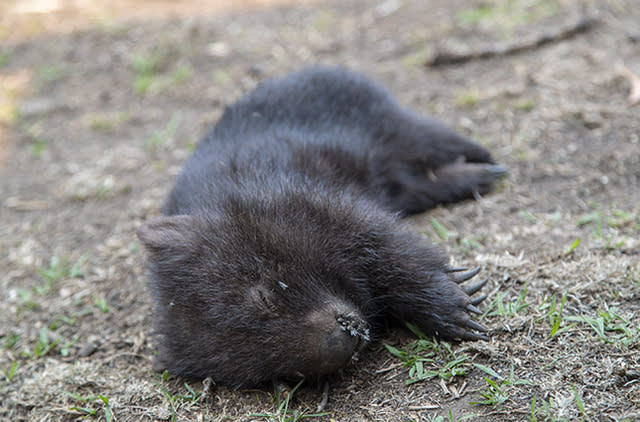'An incredibly important species': How wombats help other wildlife survive bushfires
Bushfires have destroyed houses and melted glass bottles flat against the ground, but miraculously some animals have survived.
While a Greenpeace New Zealand social media post from late last week suggesting wombats had shepherded other animals into their burrows has since been revoked, the idea that wombats saved other animals may not be entirely untrue.
Documentarian Peter Hylands ventured deep into Cobargo Wildlife Sanctuary to record the devastation and help the survivors.
The forests have been stripped of leaves and the ground is a bed of ash.
“You can see birds which were in flight and they’ve died and fallen to the ground trying to escape the fire,” Mr Hylands told Yahoo News Australia.
“And that’s a terrible, terrible thing and yet... you’ve got animals that are completely unscathed and those must be the animals that have been under the ground, it’s the only explanation when the fire zones are so extensive.”


Amid the devastation, one thing stood out.
With the undergrowth stripped bare, the complex network of wombat burrows could be seen in their entirety.
“There are quite a few wombats in that region, and there’s quite an extensive network of burrows,” Mr Hylands said.
“What was particularly amazing is it’s clearly not only wombats who are using those burrows in the firestorm.”
Wombat burrows: ‘Ecosystems in their own right’
Brigitte Stevens, from Wombat Awarenesses Organisation, told Yahoo News Australia wombats were well known for sharing their homes with other species.


She specialises in the southern hairy-nosed wombat and has documented a burrow complex with 89 entrances.
The system was spread across a 900-acre block, providing shelter to a variety of species.
“Because they live in dry and arid regions, many of the other animals rely on their burrows for survival,” she said.
“They’re incredibly important species and their burrow systems are ecosystems in their own right.
“Inside they are full of insects, reptiles, there are birds that live in their burrows, echidnas and we also see sheep and kangaroos take shelter within the entrance.
‘Physically we can’t do any more’
Donna Stepan, from Sleepy Burrows Wombat Sanctuary, has been venturing through the fire zone around Tallaganda, 50km southeast of Canberra.
While the wombat survival rate is higher than other animals, there have been many deaths.
Joeys have been left orphaned in their burrows.


“The last eight weeks have been a blur,” Ms Stepan said as she took a short break from tending to a house full of wombats.
“The sanctuary is at capacity. We are actually unable to bring many of the wombats that do need assistance into the sanctuary. “
“We’re running between 75 and 80 at any one time – physically we can’t do any more.”
Ms Stepan and her team are fitting the wild wombats with GPS devices so they can be tracked, fed and watered.
With natural food sources destroyed by the fires, human intervention is essential to their survival.
“Every time we go into the forest we are seeing more and more animals,” she said.
“It’s amazing how tolerant completely wombats are of our presence because they’re smart enough to know that we’re simply bringing food and water and then going.
“When we arrive they go into their burrows but they don’t go all the way in, they’re just waiting for us to leave and then they come out to eat and drink.
“It’s heartwarming to see.”
Governments continue to issue permits to kill wildlife
Having experienced the devastation first hand, Peter Hylands is now preparing to head back to Melbourne, to petition governments to stop issuing permits to kill native animals.
While the Victorian government announced a suspension of commercial kangaroo culling, thousands of birds and animals were killed via Authority to Kill Wildlife permits last year in that state and Mr Hylands wants them reconsidered.
The NSW government told Yahoo News Australia last week that while commercial kangaroo culling would continue, it would continue to monitor population numbers.
Mr Hylands said he is seeing signs of hope as the landscape begins its slow road to recovery, but he believes that wildlife will need unprecedented human help if it is to thrive again.

'It's lawless': Distraught carer's fears for rescued wombats after being released
'It hurt me deeply': Wildlife carer's tough decision to save a life
“One of the things we noticed within a few days of working through that region is we’re starting to see grass coming back so there’s a green tinge across the land,” he said.
“The loss of biodiversity is so huge that it seems totally absurd that governments continue to issue large numbers of permits to kill wildlife.”
Mr Hylands hopes that with the world watching, governments across the country will act quickly to ensure Australia’s diverse species survive into the future.

People wishing to donate to the groups featured in this story can do so here:
Greenpeace New Zealand has been contacted for comment.
The author, Michael Dahlstrom, is a registered wildlife carer in NSW.
Do you have a story tip? Email: newsroomau@yahoonews.com.
You can also follow us on Facebook, Instagram and Twitter and download the Yahoo News app from the App Store or Google Play.




